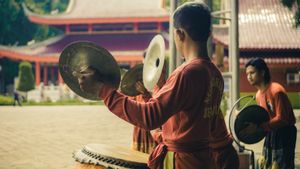YOGYAKARTA – As a trade crossing, the Strait of Malacca in the archipelago was visited by many traders from Gujarat, China, Portugal and India. It cannot be denied that cultural acculturation enriches the unique motifs and colors of Indonesian batik patterns. For example, Lasem Batik, which researchers and cultural experts call the result of Javanese and Chinese acculturation.
According to the Rembang Regency Government website, Lasem has distinctive batik characteristics that are rarely found in other areas. Apart from being done manually, or known as written batik, it is also influenced by the culture of immigrants from China. Historical stories say that Lasem was the first point on which Chinese merchants' voyages landed in Java. Even now, architectural buildings have Chinese accents in this city, which is administratively part of Rembang Regency.
Lasem Batik patterns, such as Hong Birds, Dragons and Bamboo Plants, are combined with patterns referring to the flora and situation in Lasem, namely Latoan and Kricak or Watu Pecah. Latoan is a typical Lasem plant, a type of seaweed that grows a lot around the coast and can be eaten as anointing. The Watu Pecah pattern, or Kricak, also refers to history. During the era of forced labor to build the Anyer-Panarukan road which was initiated by the Dutch Governor General Deandels, the Regent of Rembang was asked to hand over young people as workers. They were employed as stone crushers, then when a malaria and influenza epidemic occurred, many died. Based on this story, a broken stone motif was created.

The typical colors of Lasem batik are getih pitik, bottle green and dark blue. This getih pitik is red like chicken blood. These three colors are known as Batik Tiga Negeri. The batik coloring is done three times. To be more specific, here is the meaning of the typical Lasem Batik patterns.
1. Hong Bird
The Hong bird is also known as the Phoenix bird. In Chinese belief, this bird symbolizes a serious relationship between a man and a woman because it refers to feng huang. This hong bird, in principle, symbolizes seriousness in a relationship. Apart from birds, butterfly patterns also have the same meaning.

2. Peonies
Peony flowers refer to fuguihua which means honor, beauty, and eternal beauty. Reporting from Roote Trails, Monday, October 2, this peony flower motif is reddish or pink so it is suitable for a soft and sweet appearance.
3. Qilin Pattern
Unicorns are widely considered fictional fauna. Usually has horns and rainbow hair which has a distinctive philosophy. In Chinese belief, Qilin symbolizes good luck and prosperity. This fictional animal is also considered a bringer of fertility.

4. Dragon Pattern
Dragon-patterned batik is often found in Lasem. This animal symbolizes luck, birth, and good fortune. Apart from that, dragons are also a symbol of majesty and honor.
That is an explanation of the uniqueness of the Batik Lasem pattern and its meaning. Are you interested in collecting various types of Indonesian batik? Lasem Batik certainly cannot be missed.
اقرأ أيضا:
The English, Chinese, Japanese, Arabic, and French versions are automatically generated by the AI. So there may still be inaccuracies in translating, please always see Indonesian as our main language. (system supported by DigitalSiber.id)














